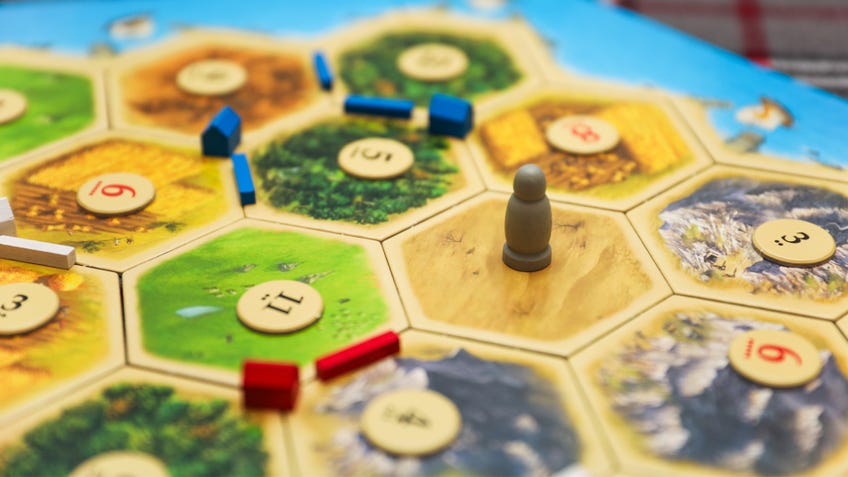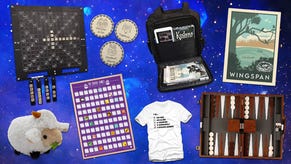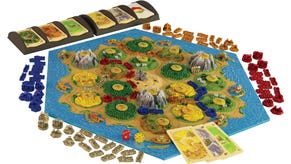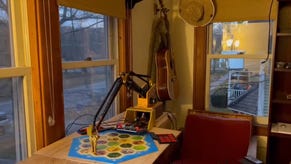How to play Catan: board game’s rules, setup and how to win explained
Wood that it were so simple.
The Settlers of Catan - or as it’s now officially called, just Catan - is a modern classic when it comes to board games. This means there's a good chance you already know how to play Catan - but there's never a bad time to brush up on the official Catan rules to make sure you're playing correctly. Here you'll be able to do exactly that.
How to play Catan
- How many people can play Catan?
- How long does Catan take to play?
- How to set up the board in Catan
- Catan player setup
- Catan rules
- How does the robber work in Catan?
- Catan development cards explained
- How to win Catan: scoring and end of the game
- How to play Catan with two players
Klaus Teuber’s game of trading and expansion is considered one of the most influential and important board games of all time, sparking a golden age of modern tabletop gaming and shifting more than 20 million copies in the 30-plus years since it was first released. It seems everyone from Frozen star Kristen Bell to pop singer Carly Rae Jepsen is a fan.
While there have been plenty of expansions and spin-offs released for Catan over the years - there’s even a big-screen movie in the works - there are still plenty of people who have never played this classic game.
If you’re yet to experience the legendary board game or simply need a refresher of the basic rules, read on and allow us to teach you how to play Catan.
How many people can play Catan?
Catan can be played by two to four players. In the board game, the players compete to gather resources and build the biggest settlements on the fictional island of Catan.
How long does Catan take to play?
Catan takes approximately one hour to play, but can take more or less time depending on the number of players, how familiar they are with the rules and what you roll!

How to set up the board in Catan
The board in Catan is modular, meaning it can be setup in a number of different variations. The more you play, the more creative you can get with how you put it together and the arrangement of starting tiles and tokens.
For your first game of Catan, of if you're playing with beginners, there is a recommended way to set up the board. (Which you’ll see right at the beginning of the Catan rulebook.)
Here are the basic steps to set up the board in Catan:
- Assemble the frame by clipping together the blue edges of the board.
- Arrange the land hex tiles in the beginner formation given in the rulebook, or shuffle them facedown and place them randomly for a variable setup.
- Place the numbered circle makers in either the beginner setup given or in alphabetical order, starting at a corner and working counter-clockwise toward the middle of the board.
- The robber pawn starts in the desert.
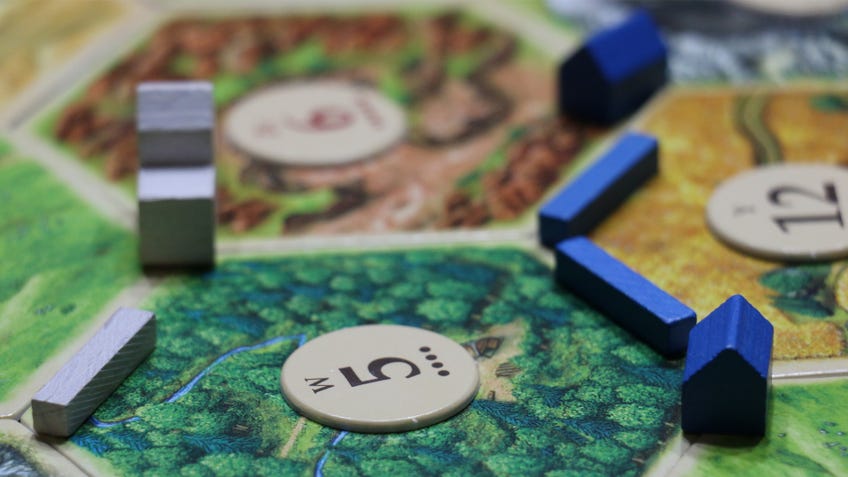
Catan player setup
Each player should choose a colour. Take the five settlements, four cities and 15 road picees in that colour and place them in front of you.
Place two settlements and two roads on the board. If you're using the recommended beginner setup, follow the layout in the rulebook. The experienced player rules instead allow each player to take it in turns to place a settlement and one adjacent road, with the order of placing reversed (so the last player goes first) to place a second settlement and adjacent road.
Each player should be given a building cost card - this will remind you what resources you’ll need to build further settlements, roads and cities, as well as buying development cards.
The Longest Road and Largest Army cards, as well as the two dice, should be placed alongside the game board.
Separate the resources into piles of their type: sheep, wood, brick, ore and wheat.
For the recommended beginner setup, you take the resources of the land surrounding the settlement marked by the white star in the rulebook: Yellow receives a sheep, a wood and a wheat. Red gets a wheat, a wood and a sheep. Blue gets a brick, a sheep and an ore. White gets an ore, a wood and a sheep.
When using the experienced player setup, you instead receive resources from each of the tiles next to your second settlement.
Catan rules
In Catan, each player turn is split into three phases:
- Resource production
- Trading
- Building
1. Resource production
Before you do anything else on your turn, you must roll the two dice. The result applies to everyone and usually means you get to take a resource from the resource stacks depending on the number you’ve rolled and where your settlements are based. For example, Red rolls a 9, which means they receive a sheep this turn as their settlement sits on the corner of a field hex with a 9 marker that produces sheep. White is on the other side of that same hex and will also receive a sheep. There is another 9 at the top of the board, too; Yellow sits on that hex and receives a wheat.
Every player needs to make sure they keep track of their own settlements and whether or not they receive a resource on any given roll.
Catan is a game of probability to a certain extent, as the resources that come up will be determined by the dice that get rolled. 7 is the most likely number to be rolled with two dice and is treated slightly differently, as it activates the Robber.
How does the robber work in Catan?
If you roll a 7 on your turn in Catan, you activate the robber.
Any player that has more than seven resource cards in their hand must return half of them (rounded down) to the resource stacks. That includes the person who activated the robber.
You now get to move the robber onto one of the number tokens on the board. Players cannot gain resources from settlements adjacent to the covered tile if that number is rolled. The lasts until the robber is moved again and uncovers the number.
As they are a robber, you also get to steal a resource at random from a player with a settlement next to the number you cover. If the robber affects more than one player, choose one to take a resource from.
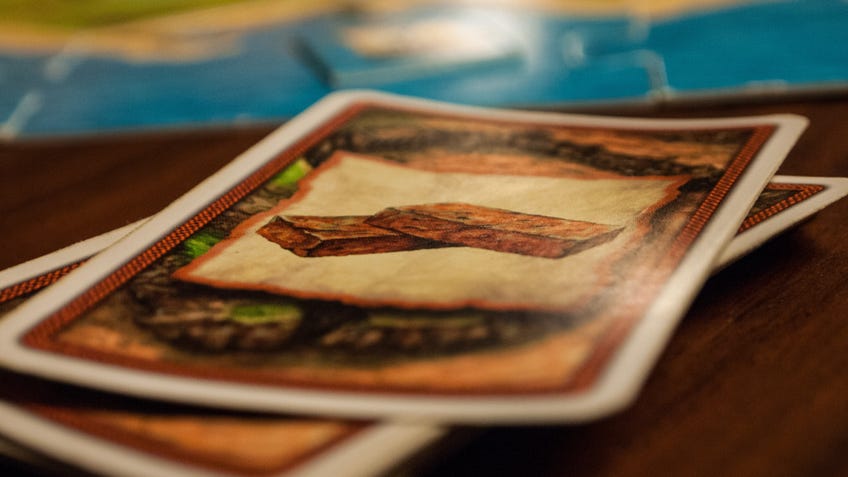
2. Trade
There are two types of trading in Catan: domestic and maritime.
Domestic trading is just a fancy way of saying you can trade with your fellow players. You can announce what you’re after and what you’d be willing to trade for it. Your fellow players can make counter offers and proposals to you (but not to each other!)
Maritime trading doesn’t involve the other players and can be incredibly useful when your opponents are being particularly stubborn about trading.
Maritime trading allows you to trade four of one good for one of another. You can perform this action this no matter what, but if you have a settlement or city on a harbour around the edge of the island, you get a rebate of some kind based on the token - such as being able to trade at 3:1 or sometimes even 2:1 for a specific resource.
3. Building
The last part of each player’s turn is the building phase. This is when you are able to build roads, settlements and cities using your collected resources, as well as buying useful development cards.
You can build any number of things on your turn as long as you have the resources available and the required building materials in your pool.
Roads
Building roads in Catan costs one brick and one wood. Roads are placed along the edges of hexes and will allow you to build settlements further afield, providing you with the opportunity to gain more resources.
The first player to build a road at least five sections long (in a single stretch - not including forks) receives the Longest Road card, which is worth two victory points at the end of the game.
If another player exceeds the length of that person’s road, they get to take that card from them - so the Longest Road card is never entirely safe in any one player’s possession.
Settlements
Building settlements in Catan costs one brick, one wood, one sheep and one wheat. Getting settlements on the board quickly can be quite an important strategy in the game, as each settlement is worth one victory point. You need 10 victory points to win the game.
You can only place a settlement somewhere that is connected by your roads and you need to be at least two spaces away from another settlement, including your own. That means no settlement can be adjacent to another settlement.
As well as giving you a precious victory point, each settlement rewards you with resources whenever one of the numbers next to it is rolled.
Cities
Building cities in Catan costs three ore and two wheat, plus an existing settlement. A city in Catan is like a hotel in Monopoly, as it upgrades your settlement by replacing it.
You can only build a city if you have a settlement on the board that can be replaced with the new city. Cities will earn you double the resources and are worth two victory points each.
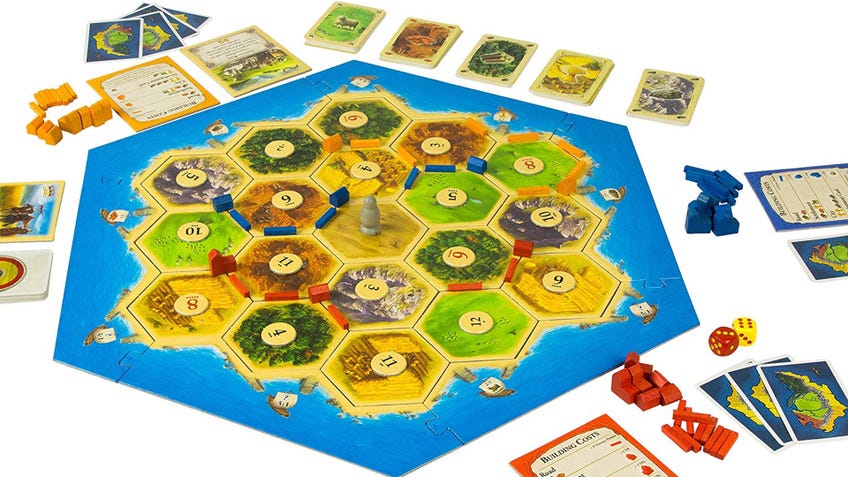
Catan development cards explained
Buying development cards in Catan is also part of the building phase and costs one sheep, one ore and one wheat. It’s a bit of a lucky dip as you are buying blindly from the shuffled deck of cards but they are all beneficial to you.
Development cards are kept hidden from your opponents until a certain point depending on the individual card. It’s important to note that you cannot play a development card on the same turn that you have bought it.
All instructions are written on the cards. There are three types of development cards in Catan: knights, progress cards and victory point cards.
Knight cards in Catan are similar to the Longest Road card in that the first player to play three knights in front of them will receive a two-point bonus for having the Largest Army. But, just like the Longest Road, this card can be stolen by another player if their army is larger than yours. Knights also activate the robber when played, in which case you behave as if you had just rolled a 7.
Progress cards in Catan vary and what they do is laid out very clearly on each card. They usually give you resources or allow you to build without spending resources. Once played, the card is removed from the game.
Victory point cards in Catan are the juiciest of the development cards, as they speed up your road to victory and remain hidden until you have enough victory points to win the game on your turn. Victory point cards are the only development cards that can be played on the same turn they are purchased.
How to win Catan: scoring and end of the game
The aim of Catan is simple: the first player to 10 victory points on their turn wins.
Make sure to keep count of your victory points (and your opponents’!) throughout the game by keeping track of buildings and any Longest Road/Largest Army bonuses.
How to play Catan with two players
The original Catan rules officially support only three or four players. However, there are a number of ways to play Catan with two players, including fan-made variants and an official two-player ruleset included in the game's Traders & Barbarians expansion. The two-player rules for Catan were later released for free during the COVID-19 pandemic.
To play Catan with two players using its official two-player rules, you will need to use the original base game in combination with 20 trade tokens. The two-player scenario essentially simulates two additional neutral players, while the 20 tokens are used by the human players to take actions.
Two-player setup
The game is set up as normal for four players, with a settlement for each of the neutral players placed according to the two-player rules' diagram. (The human players place two settlements and two roads as in the normal rules.) Each human player is given five trade tokens - these tokens can be whatever you like, whether that's coins, beads or tokens from another game.

Two-player Catan rules
On their turn, the human players roll the dice two during the resource production phase. The two results must be different; roll again if your second result matches the first. After each roll, the human players gain the resources indicated by the numbered tiles. (Or move the robber on a 7.) The neutral players never gain any resources.
If a human player builds a road or settlement, they must also build the same type of structure for one of the neutral players for free. If they can't build a settlement according to the standard rules, they should build a road instead. This only applies to settlements and roads, not cities or development cards. The neutral players cannot gain the Longest Road bonus, no matter how long their road is.
The human players can choose to spend trade tokens during their turn to perform one of two possible actions:
- Forced Trade: The player draws two random cards from their (human) opponent's hand, before giving them two cards from their own hand. If the opponent only has one card to take, the player must still give them two cards.
- Move the Robber: The player may move the robber to the desert hex.
If they have the same number of or fewer victory points than their opponent, these actions cost the player one trade token to perform. If they have more victory points, they must pay two trade tokens for each action.
Players can obtain more trade tokens by discarding a face-up knight card for two tokens (potentially losing the Largest Army card if they no longer have the most knights, or two or fewer knight cards). They will also gain two tokens if they build a settlement adjacent to the desert hex and one token if they build a settlement on the coast - or three tokens if they build a settlement that is both on the coast and adjacent to the desert. This also applies when placing settlements during setup.
Otherwise, the rules for playing Catan with two players remain mostly the same - although it's definitely recommended to play with three or four players if you can, as that's the way the game was originally intended to be played.
